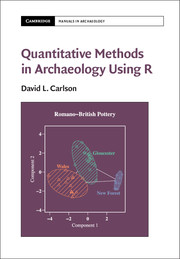Book contents
- Frontmatter
- Contents
- List of Figures
- List of Tables
- List of Boxes
- Acknowledgments
- 1 Introduction
- PART I R AND BASIC STATISTICS
- PART II MULTIVARIATE METHODS
- 10 Multiple Regression and Generalized Linear Models
- 11 MANOVA and Discriminant Analysis
- 12 Principal Components Analysis
- 13 Correspondence Analysis
- 14 Distances and Scaling
- 15 Cluster Analysis
- PART III ARCHAEOLOGICAL APPROACHES TO DATA
- References
- Index
15 - Cluster Analysis
from PART II - MULTIVARIATE METHODS
Published online by Cambridge University Press: 22 July 2017
- Frontmatter
- Contents
- List of Figures
- List of Tables
- List of Boxes
- Acknowledgments
- 1 Introduction
- PART I R AND BASIC STATISTICS
- PART II MULTIVARIATE METHODS
- 10 Multiple Regression and Generalized Linear Models
- 11 MANOVA and Discriminant Analysis
- 12 Principal Components Analysis
- 13 Correspondence Analysis
- 14 Distances and Scaling
- 15 Cluster Analysis
- PART III ARCHAEOLOGICAL APPROACHES TO DATA
- References
- Index
Summary
Cluster analysis includes a number of techniques for combining observations into groups based on one or more variables. Clustering is unsupervised classification since we do not have any information about how many groups or how they should be defined. The groups can be formed in five ways. First, we can start with all of the objects and divide them into two groups and then we can subdivide each of those groups. For example, we can separate the ceramics that have shell temper from those that have sand temper. We could divide each of those groups by the shape of the pot by separating jars from bowls. Then we could look at each of those groups and divide them by decorative techniques, such as painting, cord-marking, or incising. This is a common way of approaching artifact typology for ceramics. A second way of forming groups is to use a “type specimen.” One or more artifacts is used to identify distinct types. Then artifacts are placed with the type specimen they most closely resemble. New projectile points are classified by comparing them to established descriptions of existing types. If the specimen does not match any of the known types, a new one can be defined. Third, we can divide the specimens into groups so that each group is relatively homogeneous. This approach is similar to the type specimen approach, but we do not identify type specimens in advance although we do have to decide how many groups seem reasonable. Fourth, we could start with all of the objects and find the two that are most similar. Then the next two and so on. This process includes adding a third specimen to an existing pair and to combining two pairs into a larger group. The process continues until there is only one group. This approach requires very careful operational definitions of what “similar” means and how it is to be measured. Until computers became widely available, archaeologists rarely used this approach. Finally, we could use a distance measure (rather than a single variable) to divide the collection into more and more groups.
- Type
- Chapter
- Information
- Quantitative Methods in Archaeology Using R , pp. 318 - 346Publisher: Cambridge University PressPrint publication year: 2017



